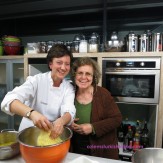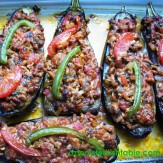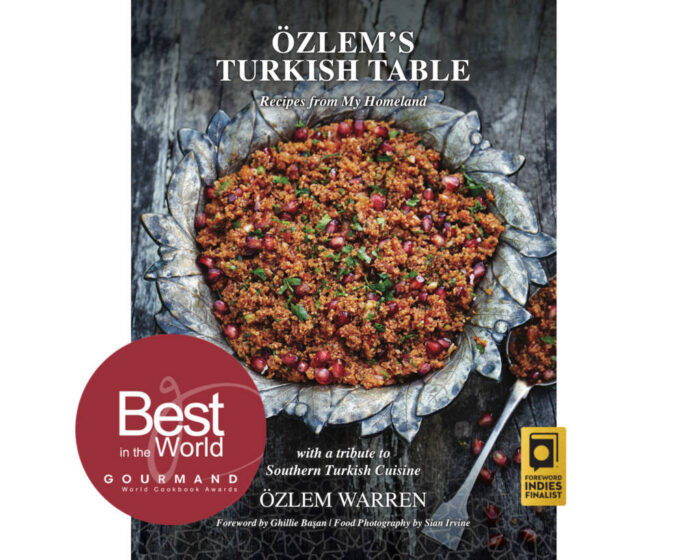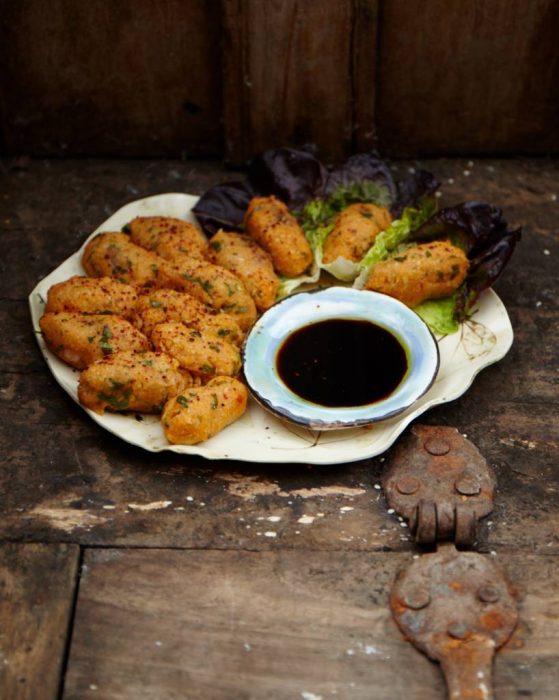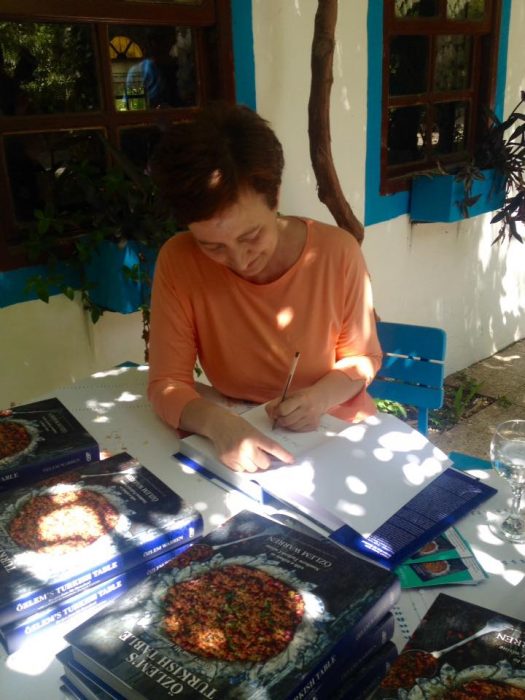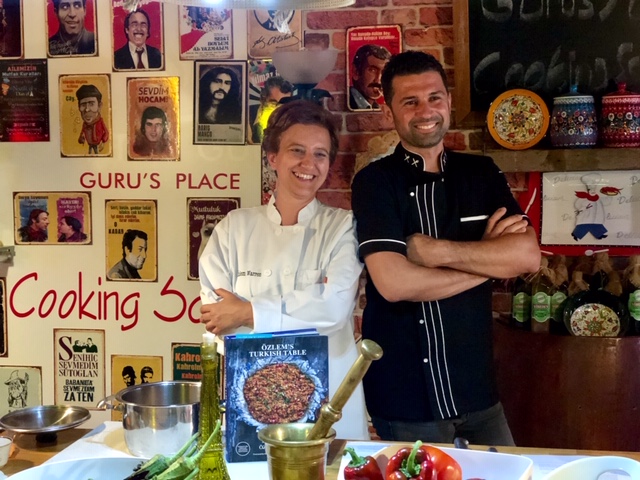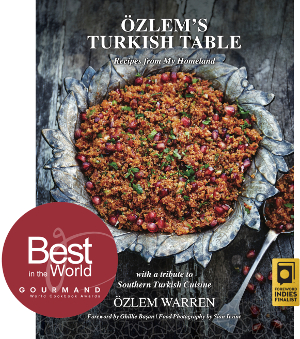
We absolutely adore manti; one of my favourite foods growing up in Turkey. I not only love the taste but the whole ritual of manti making; when I was a child, my mother would prepare the dough, cut into small squares and my father, sister, anyone around would help making these tiny dumplings. And with huge excitement, we would pour in the garlicky yoghurt and that delicious spices infused warm olive oil over to top of our manti and tuck in immediately, such special memories.

Making manti is a bit of a labor of love, but so very satisfying, delicious and I find it soothing. I previously made the traditional manti with ground/minced meat filling and recently, I made this vegetarian version with sautéed onions and chickpeas, a popular variation especially enjoyed in Central Anatolia, Turkey. It was a great success and my family loved it. Sautéed onions add a delicious natural sweetness and moisture to the earthy chickpeas. Warm, pungent cumin is made for chickpeas, and with a lovely heat from pul biber, they make a great vegetarian filling. I made these manti dumplings a bit bigger than my previous manti, hence easier to make and equally tasty. I hope you enjoy them as much as we did.


Baked dried apricots with walnuts, from Ozlem’s Turkish Table, image credit: Sian Irvine Photography
Why not serve manti with this light and delicious dessert, Dried baked apricots with walnuts, from my cookery book, Ozlem’s Turkish Table? Lovely vegan and gluten-free treat, that is so easy to make too. Signed copies of Ozlem’s Turkish Table cookery book is available at this link and delivered worldwide. Manti is not at my current cookery book, but I hope you enjoy over 90 authentic recipes in there.
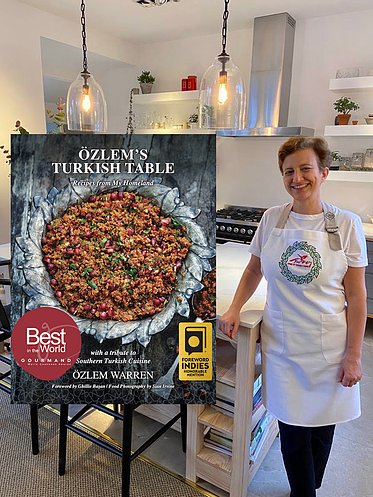
- Dough ingredients:
- 300g/10 ½ oz. all-purpose plain flour (plus a little extra for rolling)
- 1 egg, beaten
- 115ml /4fl.oz water
- 30ml/2tbsp olive oil
- 5ml/1tsp sea salt
- For the filling:
- 1 onion, very finely chopped
- 30ml/2tbsp olive oil (to sauté the onions)
- 400g/14oz cooked (can of) chickpeas, rinsed
- Small bunch of flat leaf parsley, finely chopped
- 30ml/2tbsp olive oil (to knead the filling mixture)
- 10ml/2tsp ground cumin
- 5ml/1tsp pul biber or red pepper flakes
- Salt and freshly ground black pepper to taste
- For the garlic yoghurt:
- 400g/14oz thick and creamy plain yoghurt
- 1 -2 garlic cloves, crushed and finely chopped
- Salt to taste
- For the sauce:
- 15ml/1 tbsp. Turkish hot pepper paste, biber salcasi or tomato paste
- 60ml/4 tbsp. olive oil
- 10 ml/2 tsp. dried spearmint, kuru nane
- 5 ml/1 tsp. (or more) ground sumac (optional)
- 5 ml/ 1 tsp. (or more) Turkish red pepper flakes, chili flakes, pul biber
- Preheat the oven to 180 C / 350 F
- First make the dough. Sift the flour and salt into a wide bowl and make a well in the middle. Pour in the beaten egg and the water and using your hands, draw the flour into the liquid and mix to dough. Pour in the olive oil and knead the dough for about 5-8 minutes, until it is smooth and elastic. Manti dough needs to be quite hard; cover the dough with a cling film or kitchen towel and leave to rest in a cold place or in the fridge for 30 minutes.
- In a separate bowl, beat the yoghurt with the garlic and season with salt to your taste. Cover and set aside to bring to room temperature.
- While the dough is resting, make the filling. Finely chop the onion. Heat the 30ml/2tbsp olive oil in a heavy, wide pan and stir in the onions. Sauté for 8 minutes over medium heat, stirring often. Season with salt and ground black pepper and mix well. Stir in the chopped parsley and combine well, turn the heat off to cool.
- Place the cooked and rinsed chickpeas in a large bowl. Mash them with a potato masher (I like to go hands on and mash and knead with my hands but if you find this labour intensive, you can mash in a food processor too). Stir in the cooled sautéed onions, 30ml/2 tbsp olive oil, cumin, pul biber or red pepper flakes. Season with salt and ground black pepper (this filling needs good seasoning, and its being vegetarian, you can taste the filling and adjust the seasoning to your taste). With clean hands, knead the mixture for a couple of minutes and combine well. The filling is ready.
- Cut the dough into 3 balls. Working one piece of dough at a time (and cover the rest of the dough balls with a cling film in the meantime so they don’t dry out), roll the dough as thinly as you can into a sheet, on a lightly floured surface. Using a sharp knife, cut the dough into small squares (roughly 4cm/1 ½ in). Spoon a teaspoon of the filling, rounded at a size of a chickpea into the middle of each square. Pinch the opposite corners to form a little a little pouch and press the seams together to seal firmly. Make sure to lightly flour your hands if handling the dough becomes sticky, so that you can seal the manti well.
- Repeat with the rest of the dough and place the stuffed dumplings in a greased oven proof dish, stacking them next to one another in one layer. Bake uncovered for 8 - 10 minutes, until the manti, dumplings start to get a light golden colour. Take them out of the oven and let the manti cool. You can freeze some of this baked manti at this point, in a sealed bag for up to 3 weeks.
- Pour the hot water and pinch of salt to a large pan and bring to the boil. Place the baked dumplings gently to the boiling water and simmer for about 8- 10 minutes, until they are cooked. Once cooked, drain the water and return the manti to the pan. Drizzle a little oil over them so that they don’t stick together.
- While manti is cooking, prepare your sauce. Heat the oil in a wide pan and add the hot pepper paste, biber salcasi or the tomato paste. Stir in pul biber or red pepper flakes, dried mint and sumac, combine well and simmer for 1-2 minutes.
- Arrange manti on a serving dish and spoon the garlic yogurt over them. Then drizzle spices infused olive oil with the tomato/red pepper paste sauce over the garlic yoghurt. You can decorate with extra red pepper flakes, dried mint and sumac and serve immediately.
- Afiyet Olsun.
Ozlem’s Simit and Turkish Breakfast Online (Zoom) Cookery Class
Saturday, March 27th, 2021, 6 pm – 8 pm (GMT) – SOLD OUT
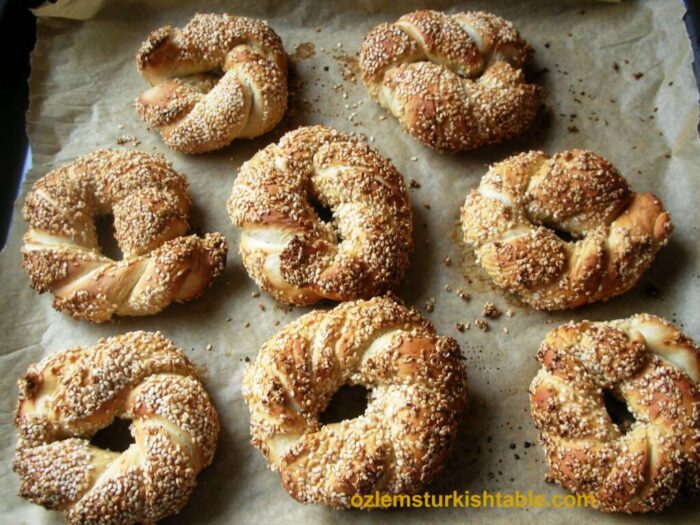
Thank you so much for your keen interest for my Simit and Turkish Breakfast zoom class – as March 20th class Sold Out so quickly, I am doing another Simit and Turkish breakfast zoom class on Saturday, March 27th.
Turkish breakfast, kahvalti, is my favourite meal and I am so very much looking forward to recreating some of my Turkish breakfast favourites at my zoom cookery class on Saturday, March 27th, 2021, 6 pm – 8 pm (GMT). This class will feature our iconic street food, Simit, Sesame encrusted bread rings – it is so much fun making simit at home, and I will show you how. This class menu also includes a delicious Olive Salad with pomegranate molasses from my hometown Antakya, Zeyting Ufeleme, Eggs with Spinach and Onion, Ispanakli Yumurta and Dried fig jam – all these will wonderfully complement our Simit and Turkish breakfast.
Date: Saturday, March 27th 2021
Time: 6pm- 8pm (GMT)
Cost: 35 GBP per person
This is a slightly longer class, as the Simit dough will need to prove and we will make in total 4 recipes for our Turkish breakfast feast.
You will get plenty of ahead of time preparation tips, ideas for substitution and with stories from my homeland. Recording of the class will also be sent to the participants for limited viewing. The class would also make a wonderful gift for a foodie.
Upon registration, you will get a confirmation email. The zoom link to join the class, recipe pack and ingredients list will be emailed a week before the class. Please note that no refund will be issued.
Do hope you can join us to make this delicious Turkish breakfast feast and take a virtual culinary journey to Turkey!
For private group classes, please email ozlem@ozlemsturkishtable.com, I look forward to cooking together.
Afiyet Olsun,
Ozlem
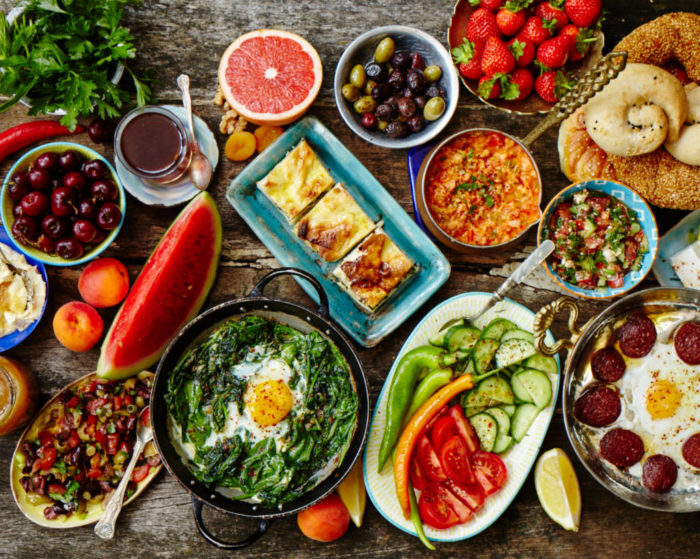
Turkish Breakfast spread from Ozlem’s Turkish Table cookery book, by Sian Irvine Photography


